Related Research Articles
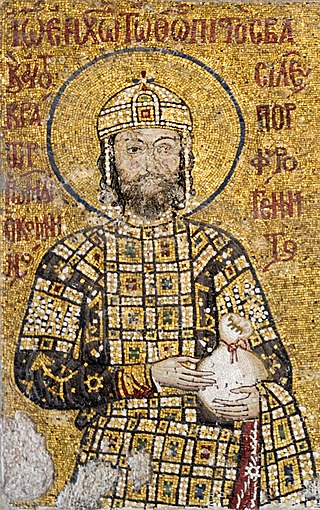
John II Komnenos or Comnenus was Byzantine emperor from 1118 to 1143. Also known as "John the Beautiful" or "John the Good", he was the eldest son of Emperor Alexios I Komnenos and Irene Doukaina and the second emperor to rule during the Komnenian restoration of the Byzantine Empire. As he was born to a reigning emperor, he had the status of a porphyrogennetos. John was a pious and dedicated monarch who was determined to undo the damage his empire had suffered following the Battle of Manzikert, half a century earlier.
The Battle of Myriokephalon was a battle between the Byzantine Empire and the Seljuk Turks in Phrygia in the vicinity of Lake Beyşehir in southwestern Turkey on 17 September 1176. The battle was a strategic reverse for the Byzantine forces, who were ambushed when moving through a mountain pass.
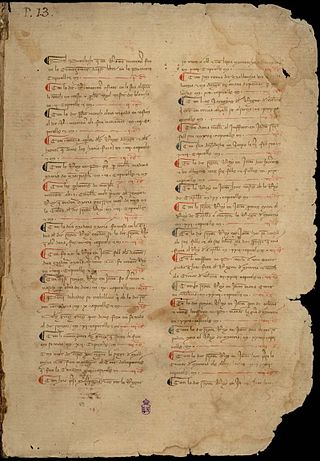
The Catalan Company or the Great Catalan Company was a company of mercenaries led by Roger de Flor in the early 14th century and hired by the Byzantine Emperor Andronikos II Palaiologos to combat the increasing power of the Anatolian beyliks. It was formed by almogavar veterans of the War of the Sicilian Vespers, who had remained unemployed after the signing in 1302 of the Peace of Caltabellotta between the Crown of Aragon and the French dynasty of the Angevins.

The Battle of Dyrrhachium took place on October 18, 1081 between the Byzantine Empire, led by the Emperor Alexios I Komnenos, and the Normans of southern Italy under Robert Guiscard, Duke of Apulia and Calabria. The battle was fought outside the city of Dyrrhachium, the major Byzantine stronghold in the western Balkans, and ended in a Norman victory.

The Battle of Kalavrye was fought in 1078 between the Byzantine imperial forces of general Alexios Komnenos and the rebellious governor of Dyrrhachium, Nikephoros Bryennios the Elder. Bryennios had rebelled against Michael VII Doukas and had won over the allegiance of the Byzantine army's regular regiments in the Balkans. Even after Doukas's overthrow by Nikephoros III Botaneiates, Bryennios continued his revolt, and threatened Constantinople. After failed negotiations, Botaneiates sent the young general Alexios Komnenos with whatever forces he could gather to confront him.
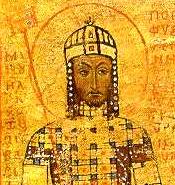
The Battle of Sirmium, Battle of Semlin or Battle of Zemun was fought on July 8, 1167 between the Byzantine Empire, and the Kingdom of Hungary. The Byzantines achieved a decisive victory, forcing the Hungarians to sue for peace on Byzantine terms. The battle consolidated Byzantine control of the western Balkans.

The Byzantine army of the Komnenian era or Komnenian army was the force established by Byzantine emperor Alexios I Komnenos during the late 11th/early 12th century, and perfected by his successors John II Komnenos and Manuel I Komnenos during the 12th century. From necessity, following extensive territorial loss and a near disastrous defeat by the Normans of southern Italy at Dyrrachion in 1081, Alexios constructed a new army from the ground up. This new army was significantly different from previous forms of the Byzantine army, especially in the methods used for the recruitment and maintenance of soldiers. The army was characterised by an increased reliance on the military capabilities of the immediate imperial household, the relatives of the ruling dynasty and the provincial Byzantine aristocracy. Another distinctive element of the new army was an expansion of the employment of foreign mercenary troops and their organisation into more permanent units. However, continuity in equipment, unit organisation, tactics and strategy from earlier times is evident. The Komnenian army was instrumental in creating the territorial integrity and stability that allowed the Komnenian restoration of the Byzantine Empire. It was deployed in the Balkans, Italy, Hungary, Russia, Anatolia, Syria, the Holy Land and Egypt.
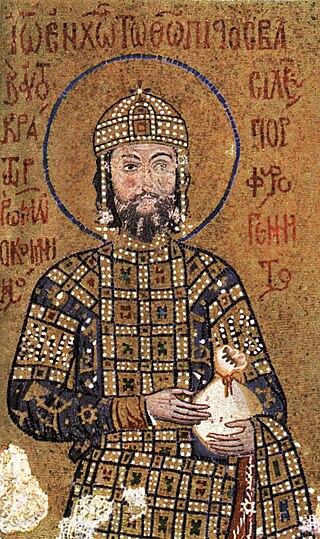
The Battle of Beroia was fought in 1122 between the Pechenegs and the Byzantine Empire under Emperor John II Komnenos in what is now Bulgaria. The Byzantine army won the battle, resulting in the disappearance of the Pechenegs as a distinct, independent people.
The Byzantine–Seljuk wars were a series of decisive battles that shifted the balance of power in Asia Minor and Syria from the Byzantine Empire to the Seljuks. Riding from the steppes of Central Asia, the Seljuks replicated tactics practiced by the Huns hundreds of years earlier against a similar Roman opponent but now combining it with new-found Islamic zeal. In many ways, the Seljuk resumed the conquests of the Muslims in the Byzantine–Arab Wars initiated by the Rashidun, Umayyad and Abbasid Caliphates in the Levant, North Africa and Asia Minor.

The Byzantine Empire was ruled by emperors of the Komnenos dynasty for a period of 104 years, from 1081 to about 1185. The Komnenian period comprises the reigns of five emperors, Alexios I, John II, Manuel I, Alexios II and Andronikos I. It was a period of sustained, though ultimately incomplete, restoration of the military, territorial, economic and political position of the Byzantine Empire.

The Battle of Philomelion of 1116 consisted of a series of clashes over a number of days between a Byzantine expeditionary army under Emperor Alexios I Komnenos and the forces of the Sultanate of Rûm under Sultan Malik Shah; it occurred in the course of the Byzantine–Seljuk wars. The Seljuk forces attacked the Byzantine army a number of times to no effect; having suffered losses to his army in the course of these attacks, Malik Shah sued for peace.
The Battle of Hyelion and Leimocheir saw the almost complete destruction by the Byzantines of a large Seljuq Turk army. The Seljuq army had been raiding Byzantine territory in the Maeander Valley in Anatolia, and had sacked a number of cities. The Byzantine force ambushed the Turks at a river crossing.
The Battle of Adramyttion occurred on 19 March 1205 between the Latin Crusaders and the Byzantine Greek Empire of Nicaea, one of the kingdoms established after the fall of Constantinople to the Fourth Crusade in 1204. It resulted in a comprehensive victory for the Latins. There are two accounts of the battle, one by Geoffrey de Villehardouin, and the other by Nicetas Choniates, which differ significantly.
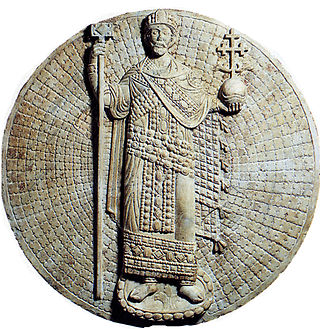
The Battle of Haram or Chramon was fought between the forces of King Stephen II of Hungary and Emperor John II Komnenos of the Byzantine Empire in the year 1128, or possibly earlier – in 1125, in what is now Serbia, and resulted in a major defeat for the Hungarians.
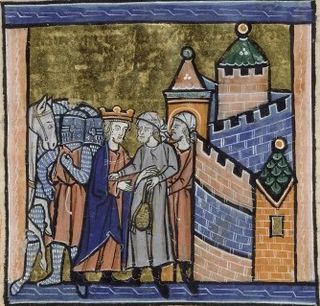
The siege of Shaizar took place from April 28 to May 21, 1138. The allied forces of the Byzantine Empire, Principality of Antioch and County of Edessa invaded Muslim Syria. Having been repulsed from their main objective, the city of Aleppo, the combined Christian armies took a number of fortified settlements by assault and finally besieged Shaizar, the capital of the Munqidhite Emirate. The siege captured the city, but failed to take the citadel; it resulted in the Emir of Shaizar paying an indemnity and becoming the vassal of the Byzantine emperor. The forces of Zengi, the greatest Muslim prince of the region, skirmished with the allied army but it was too strong for them to risk battle. The campaign underlined the limited nature of Byzantine suzerainty over the northern Crusader states and the lack of common purpose between the Latin princes and the Byzantine emperor.
John Komnenos Vatatzes,, or simply John Komnenos or John Vatatzes in the sources, was a major military and political figure in the Byzantine Empire during the reigns of Manuel I Komnenos and Alexios II Komnenos. He was born c. 1132, and died of natural causes during a rebellion he raised against Andronikos I Komnenos in 1182.
The Battle of Constantinople in 1147 was a large-scale clash between the forces of the Byzantine Empire and the German crusaders of the Second Crusade, led by Conrad III of Germany, fought on the outskirts of the Byzantine capital, Constantinople. The Byzantine emperor Manuel I Komnenos was deeply concerned by the presence of a large and unruly army in the immediate vicinity of his capital and of the unfriendly attitude of its leaders. A similarly sized French crusader army was also approaching Constantinople, and the possibility of the two armies combining at the city was viewed with great alarm by Manuel. Following earlier armed clashes with the crusaders, and perceived insults from Conrad, Manuel arrayed some of his forces outside the walls of Constantinople. Part of the German army then attacked and was defeated; according to British historian Michael Angold, they suffered heavy losses. Following this defeat the crusaders agreed to be quickly ferried across the Bosporus to Asia Minor.
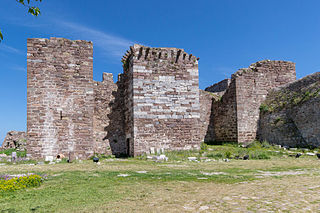
The Ottoman conquest of Lesbos took place in September 1462. The Ottoman Empire, under Sultan Mehmed II, laid siege to the island's capital, Mytilene. After its surrender, the other forts of the island surrendered as well. The event put an end to the semi-independent Genoese lordship that the Gattilusio family had established in the northeastern Aegean since the mid-14th century, and heralded the beginning of the First Ottoman–Venetian War in the following year.
The siege of Claudiopolis was a Byzantine victory over a Seljuq Turk army in February–March 1179.
The siege of Laodicea resulted in the Byzantine capture of the Seljuq Turkish city of Laodicea in 1119.
References
Primary
- Magoulias, Harry J., ed. (1984). O City of Byzantium: Annals of Niketas Choniatēs. Detroit: Wayne State University Press. ISBN 978-0-8143-1764-8.
Secondary
- Birkenmeier, John W. (2002). The Development of the Komnenian Army: 1081-1180. Boston, Massachusetts: Brill. ISBN 90-04-11710-5.